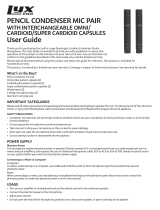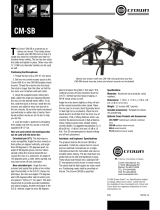
CHOOSING THE RIGHT
CROWN MICROPHONE
There’s a wide variety of Crown microphones to
choose from. This guide will help you select the
microphones best-suited for your applications.
Transducer Type
Condenser or Dynamic
In a dynamic microphone, a coil of wire attached to a
diaphragm is suspended in a magnetic field and
generates an electrical signal similar to the incoming
sound wave.
In a condenser microphone, a diaphragm and an
adjacent metallic disk (backplate) are charged to form
two plates of a capacitor. Sound waves striking the
diaphragm vary the spacing between the plates; this
varies the capacitance and generates an electrical
signal similar to the incoming sound wave.
The diaphragm and backplate can be charged either
by an externally applied voltage, or by a permanently
charged electret material in the diaphragm or on the
backplate.
Because of its lower diaphragm mass and higher
damping, a condenser microphone responds faster
than a dynamic microphone to rapidly changing
sound waves (transients).
Dynamic microphones offer good sound quality, are
especially rugged, and require no power supply.
Condenser microphones require a power supply to
operate internal electronics, but generally provide a
clear, detailed sound quality with a wider, smoother
response than dynamics.
Boundary or Free Field
Boundary microphones are meant to be used on large
surfaces such as stage floors, piano lids, hard-surfaced
panels, or walls. Boundary mics are specially designed
to prevent phase interference between direct and
reflected soundwaves, and have little or no off-axis
coloration. Free-field microphones are meant to be
used away from surfaces, say for up-close miking.
Crown Pressure Zone Microphones (PZMs) and
Phase Coherent Cardioids (PCCs) are boundary
microphones; Crown GLMs, CMs and LMs are
free-field microphones.
Polar Patterns
Omnidirectional or Unidirectional
Omnidirectional microphones (also called pressure
microphones) are equally sensitive to sounds coming
from all directions. Unidirectional microphones (also
called pressure gradient microphones) are most
sensitive to sounds coming from one direction - in
front of the microphone.
Three types of unidirectional patterns are the car-
dioid, supercardioid, and hypercardioid pattern. The
cardioid pattern has a broad pickup area in front of
the microphone. Sounds approaching the side of the
mic are rejected by 6 dB; sounds from the rear (180˚
off-axis) are rejected 20 to 30 dB. The supercardioid
rejects the side sounds by 8.7 dB, and rejects sound
best at two “nulls” behind the microphone, 125˚ off-
axis.
The hypercardioid pattern is the tightest pattern of the
three (12 dB down at the sides), and rejects sound
best at two nulls 110˚ off-axis. This pattern has the
best rejection of room acoustics, and provides the
most gain-before-feedback from the main sound
reinforcement speakers.
Choose omnidirectional mics when you need:
All-around pickup.
Pickup of room acoustics.
Extended low-frequency response.
Low handling noise.
Low wind noise.
No up-close bass boost.
Choose unidirectional mics when you need:
Selective pickup.
Rejection of sounds behind the microphone.
Rejection of room acoustics and leakage.
More gain-before-feedback.
Up-close bass boost (proximity effect).
An omnidirectional boundary microphone (such as
PZM) has a half-omni or hemispherical polar pattern.
A unidirectional boundary microphone (such as a
PCC-160) has a half-supercardioid polar pattern. The
boundary mounting increases the directionality of the
microphone, thus reducing pickup of room acoustics.
Frequency Response
Bright or Flat
A bright frequency response tends to have an empha-
sized or rising high-frequency response, which adds
clarity, brilliance, and articulation. A flat frequency
response tends to sound natural. Microphone place-
ment also has a major effect on the recorded tonal
balance. With loud guitars, amps and drums, a mic
with rising highs or presence peak tends to sound
natural; a flat-response mic tends to sound dull.
14
INTRODUCTION
In this guide you’ll find suggestions on using
Crown microphones effectively. The CM, GLM, and
LM microphone lines are covered in this booklet. For
application notes on the PZM®, PCC® and SASS®,
please see the Crown Boundary Mic Application Guide.
You will find that Crown microphones can solve many
of your audio problems.
MICROPHONE
TECHNIQUE BASICS
How to reduce feedback
Feedback is a squealing sound from sound-reinforce-
ment speakers that occurs when volume is too high.
To reduce feedback:
• Turn down the volume on the offending
microphone until feedback stops.
• Use as few microphones as possible. Gain-before-
feedback decreases 3 dB each time the number of
open mics doubles.
• Place the mic close to the sound source. The closer
the mic, the higher the gain-before-feedback. If close
miking causes an unnatural tone quality, try using
EQ to compensate.
• Equalize the sound system with a 1/3 octave graphic
equalizer. Notch out frequencies that feedback.
• Place speakers as far from the mic as possible.
• Place the mics behind or to the outside of the house
P.A. speakers. The house speakers should not aim at
the microphones.
• Use directional mics. Hypercardioid and supercar-
dioid patterns reject feedback better than cardioids,
and cardioids reject feedback better than omnidirec-
tional patterns.
• Use differential (noise-cancelling) mics, such as the
Crown CM-310A or CM-311A. They have the
highest gain before feedback of any mic you can buy.
The following table tells how many dB of feedback
rejection you can expect from various polar patterns,
in a reverberant sound field, compared to an omnidi-
rectional pattern at the same distance:
Omnidirectional 0.0 dB
Cardioid -4.8 dB
Bidirectional -4.8 dB
Supercardioid -5.7 dB
Hypercardioid -6.0 dB
For example, a cardioid mic provides 4.8 dB more
gain-before-feedback than an omni mic at the same
distance from the sound source.
You can place a directional mic farther from its source
than an omnidirectional mic in a reverberant sound
field and have the same gain-before-feedback. The
table below shows the distance multiplier for each
pattern:
Omnidirectional 1.0
Cardioid 1.7
Bidirectional 1.7
Supercardioid 1.9
Hypercardioid 2.0
For example, if an omni mic is one foot from a sound
source, a supercardioid mic can be placed 1.9 feet and
have the same gain-before-feedback as the omni.
The figures above apply only when the mics are in a
reverberant sound field - say, when the P.A. speakers
are distant from the mics and the sound system is set
up indoors.
How to reduce reverberation
Reverberation is sometimes loosely called “room
acoustics” or “ambience.” It is a pattern of sound
reflection off the walls, ceiling, and floor. For example,
reverberation is the sound you hear just after you
shout in an empty gymnasium. Too much
reverberation in a recording can make the recorded
instrument sound distant or muddy. To reduce
reverberation:
• Place the mic closer to the sound source.
• Pick up electric instruments with a direct box or
cable.
• Use a room or studio with dead acoustics. The walls,
ceiling, and floor should be covered with a sound-
absorbing material.
• Use directional microphones. Hypercardioid and
supercardioid patterns reject reverb more than
cardioid. Cardioid and bidirectional patterns
reject reverb equally well. Cardioid rejects reverb
more than an omnidirectional pattern at the
same distance:
Omnidirectional 0.0 dB
Cardioid -4.8 dB
Bidirectional -4.8 dB
Supercardioid -5.7 dB
Hypercardioid -6.0 dB
3
















